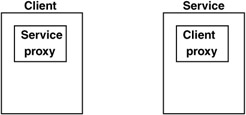132.
|
Listener SourceThe ordinary Java event model has all objects in a single address space, so that registration of event listeners and notifying these listeners all takes place using objects in the one space. We have already seen that this is not the case with Jini. Jini is a networked federation of objects, and in many cases one is dealing with proxy objects, not the real objects. This is the same with remote events, except that in this case we often have the direction of proxies reversed . To see what I mean by this, consider what happens if a client wants to monitor any changes in the service. The client will already have a proxy object for the service, and it will use this proxy to register itself as a listener. However, the service proxy will most likely just hand this listener back off to the service itself (that is what proxies, such as RMI proxies, do). So we need to get a proxy for the client over to the service. Consider the file classification problems we looked at in earlier chapters. The file classifier had a hard-coded set of filename extensions built in. However, it would be possible to extend these, if applications come along that know how to define (and maybe handle) such extensions. For example, an application would locate the file classification server, and using an exported method from the file classification interface would add the new MIME type and file extension. This is no departure from any standard Java or earlier Jini stuff. It only affects the implementation level of the file classifier, changing it from a static list of filename extensions to a more dynamic one. What it does affect is the poor application that has been blocked (and is probably sleeping) on an unknown filename extension. When the classifier installs a new file type, it can send an event saying so. The blocked application could then try again to see if the extension is now known. If so, it uses it, and if not, it blocks again. Note that we don't bother with identifying the actual state change, since it is just as easy to make another query once you know that the state has changed. More complex situations may require more information to be maintained . However, in order to get to this situation, the application must have registered its interest in events, and the event producer must be able to find the listener. How this gets resolved is for the client to first find the service in the same way as we discussed in Chapter 6. The client ends up with a proxy object for the service in the client's address space. One of the methods on the proxy will add an event listener, and this method will be called by the client. For simplicity, assume that the client is being added as a listener to the service. The client will call the add listener method of the proxy, with the client as parameter. The proxy will then call the real object's add listener method, back on its server side. But in doing this, we have made a remote call across the network, and the client, which was local to the call on the proxy, is now remote to the real object, so what the real object is getting is a proxy to the client. When the service makes notification calls to the proxy listeners, the client's proxy can make a remote call back to the client itself. These proxies are shown in Figure 14-3.  Figure 14-3: Proxies for services and listeners | ||||
EAN: N/A
Pages: 189
If you may any questions please contact us: flylib@qtcs.net
